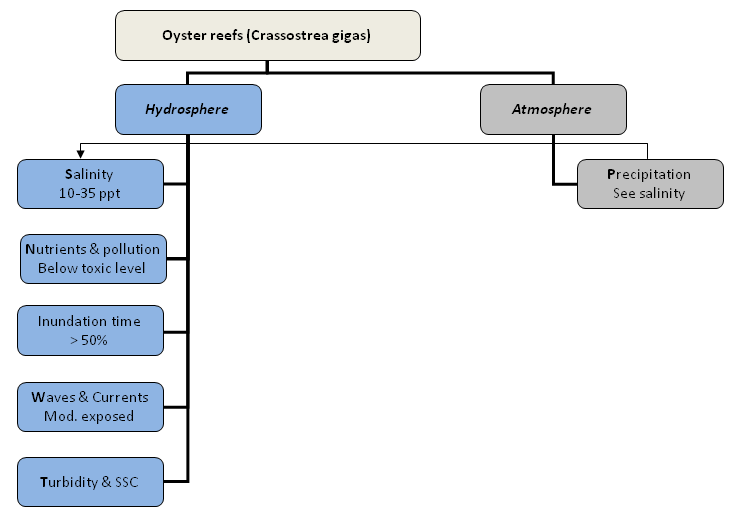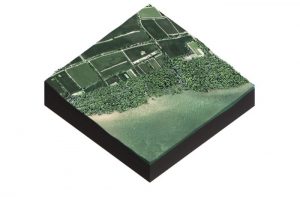Hydrosphere (water on or near the earth) – mangroves
Salinity: The Pacific Oyster can live under a wide range of salinity concentrations from 10 to 35 ppt. Oyster reefs in the intertidal are best created at intermediate salinities around 20-25 ppt (Troost, 2010).

Nutrients and Pollution: Oyster reefs are not directly sensitive to high nutrient levels, but eutrophication has some indirect effects on oyster survival. Eutrophication can indirectly kill oysters by inducing local anoxic conditions at the bottom (Lenihan, 1999) or increasing the probability of harmful algal blooms. Oysters feeding on the algae in the water can get killed by so called dinoflagellates. High nutrient concentrations and the presence of harmful algal blooms or bacteria can also make shellfish unsuitable for human consumption (Rippey, 1994; Etheridge, 2010). Polluting substances can kill oysters directly, or accumulate in the oysters meat, making them unsuitable for human consumption (Baudrimont et al., 2005).
Inundation time: The inundation time depends on the position in the intertidal zone and the tidal regime. Inundation time is crucial for the occurrence and survival of oysters as it determines factors such as food availability, larval settlement, predation and heat stress. Short inundation times can be tolerated, but means the oysters have less time to feed and more time for overheating and dehydration. Experiments in the Netherlands revealed that oyster larvae settle most and grow best in the intertidal zone 60 cm below the mean sea level (NAP, Normaal Amsterdams Peil)(Walles, unpublished). This value will be variable across sites, as it depends on local tidal regimes and other environmental conditions such as predation and ambient temperatures. The tidal range in which oysters can survive is therefore best tested at specific locations. Roughly speaking, self-sustaining oyster reefs can best be created at places that are inundated 40-50% of the time or more.
Waves & currents: Wave action (and strong water currents) can dislodge oysters, re-suspend sediment and cause erosion. Whether oyster reefs can establish depends on local hydrodynamics and the presence of suitable (natural or artificial) substrate. In sheltered areas, living reefs may be created by supplying loose hard substrates for oyster larvae settlement, whereas at more exposed sites (in particular wave-dominated) substrates need to be fixed in cages. Such cages will keep the substrate from being spread around and getting smothered, thus increasing the survival rate of settled oyster larvae. Especially when aimed at coastal protection, the use of a certain type of cage will be necessary in most cases (see lithosphere). In the Eastern Scheldt, experiments with loose oyster shells at an exposed site resulted in the complete loss of the shells during stormy conditions. Therefore, the use of gabions filled with oyster shells was introduced in the Case Shellfish Reefs.
Turbidity and SSC: Increased suspended sediment concentrations can affect filterfeeding organisms like oysters through clogging and damaging their feeding and breathing facilities. When the Suspended Sediment Concentration (SSC) is too high, gills of filtrating oysters can get clogged (Troost, 2010). On the other hand, oysters can also be used as a biofilter to reduce phytoplankton concentrations and turbidity in shallow waters (Grabowski et al., 2007).

